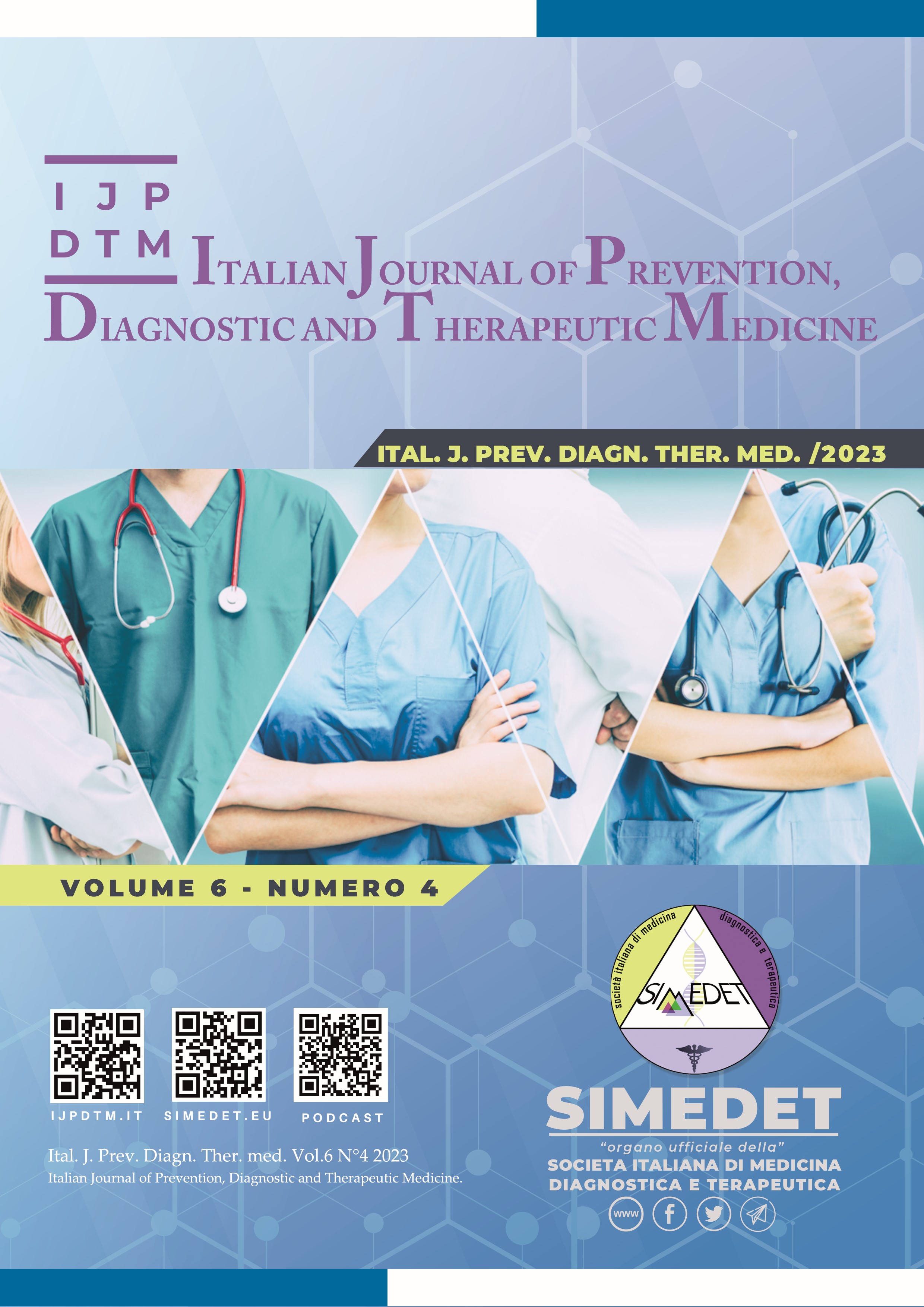Qualitative study on the behavior of nurses in relation to the prevention of pneumonia associated with mechanical ventilation within an intensive care unit
Main Article Content
Abstract
Background: Ventilator-associated pneumonia (VAP) is a common challenge in intensive care units (ICUs) worldwide, responsible for major complications and adverse events impacting patient health and safety. Consequently, the quality of care is crucial for the prevention of VAP.
Participants and Research Context: This study describes nursing care in the Intensive Care Unit of the University Hospital of Cagliari, where interventions implemented by nursing staff for the prevention of VAP were observed.
Objective: To investigate the factors and nursing interventions in the ICU that significantly reduce the onset of VAP and to collect the outcomes emerging from the nursing interventions implemented by the staff, as well as from interviews conducted during the study period. This led to the identification of potential corrective actions aimed at significantly reducing VAP incidence rates.
Methods: A qualitative phenomenological approach was used, employing Interpretative Phenomenological Analysis (IPA), which highlights the personal opinions, training, and professional experiences of nurses in managing VAP prevention in ICU patients. The data collection tool was the individual semi-structured interview, the most commonly used method in IPA. Additionally, by comparing guidelines and scientific publications, a checklist was used, allowing for an objective assessment of the nursing staff's performance involved in the study through the use of surveillance cameras within the patient rooms.
Ethical Considerations: Participation in the study was voluntary, and all participants consented to the anonymous processing of their data.
Results and Conclusions: Among the solutions identified, the importance of continuous training for nursing staff in VAP prevention was noted, aiming to enhance the efficiency of nursing care for patients and the prevention of this issue. It was highlighted how nursing staff, in collaboration with medical personnel, could use assessment scales for the early diagnosis of VAP. The urgent need to improve certain care practices through increased staffing of updated and trained health professionals was recognized, ensuring comprehensive care management in preventing VAP. These results, compared with those already analyzed in the literature, demonstrate the significance of the nursing role and the interventions it carries out in preventing ventilator-associated pneumonia.
Downloads
Article Details

This work is licensed under a Creative Commons Attribution-NonCommercial 4.0 International License.
References
Albertos, R., Caralt, B., &Rello, J. (2011). Ventilator-associated pneumonia management in criticalillness. Current Opinion in Gastroenterology, 27(2), 160–166. https://doi.org/10.1097/mog.0b013e32834373b1
Kalanuria, A., Zai, W., &Mirski, M. (2014). Ventilator-associated pneumonia in the ICU. Critical Care (London, England), 18(2), 208. https://doi.org/10.1186/cc13775
Smeltzer, S. C. (2010). Handbook for Brunner and suddarth’s textbook of medical-surgical nursing (12th ed.). Lippincott Williams and Wilkins.
Jansson, M., Ala-Kokko, T., Ylipalosaari, P., Syrjälä, H., & Kyngäs, H. (2013). Critical care nurses’ knowledge of, adherence to and barriers towards evidence-based guidelines for the prevention of ventilator-associated pneumonia--a survey study. Intensive & Critical Care Nursing: The Official Journal of the British Association of Critical Care Nurses, 29(4), 216–227. https://doi.org/10.1016/j.iccn.2013.02.006
Smith, J. A., Flowers, P., & Larkin, M. (2022). Interpretative phenomenological analysis: Theory, method and research (2nd ed.). SAGE Publications.
Kwak, S., & Han, S. (2022). Development of a tool for measuring ventilator-associated pneumonia prevention behaviors of intensive care unit nurses. International Journal of Environmental Research and Public Health, 19(14), 8822. https://doi.org/10.3390/ijerph19148822
Samanta, S., Patnaik, R., Azim, A., Gurjar, M., Baronia, A. K., Poddar, B., Singh, R. K., &Neyaz, Z. (2021). Incorporating Lung Ultrasound in Clinical Pulmonary Infection Score as an Added Tool for Diagnosing Ventilator-associated pneumonia: A Prospective Observational Study from a Tertiary Care Center. Indian Journal of Critical Care Medicine: Peer-Reviewed, Official Publication of Indian Society of Critical Care Medicine, 25(3), 284–291. https://doi.org/10.5005/jp-journals-10071-23759
Cabrini, L., Landoni, G., Oriani, A., Plumari, V. P., Nobile, L., Greco, M., Pasin, L., Beretta, L., & Zangrillo, A. (2015). Noninvasive ventilation and survival in acute care settings: A comprehensive systematic review and metaanalysis of randomized controlled trials. Critical Care Medicine, 43(4), 880–888. https://doi.org/10.1097/ccm.0000000000000819
Ferreira, J., & Bajwa, A. A. (2016). What’s new in critical illness and injury science? Pneumonia prevention in the ICU remains a challenge. International Journal of Critical Illness and Injury Science, 6(1), 1–2. https://doi.org/10.4103/2229-5151.177363
Chahoud, J., Semaan, A., & Almoosa, K. F. (2015). Ventilator-associated events prevention, learning lessons from the past: A systematic review. Heart & Lung: The Journal of Critical Care, 44(3), 251–259. https://doi.org/10.1016/j.hrtlng.2015.01.010
Panchabhai, T. S., & Dangayach, N. S. (2009). Role of chlorhexidine gluconate in ventilator-associated pneumonia prevention strategies in ICU patients: where are we headed? Critical Care (London, England), 13(6), 427. https://doi.org/10.1186/cc8165
Rose, L., & Redl, L. (2008). Survey of cuff management practices in intensive care units in Australia and New Zealand. American Journal of Critical Care: An Official Publication, American Association of Critical-Care Nurses, 17(5), 428–435. https://doi.org/10.4037/ajcc2008.17.5.428
Dehghan, M., Arab, M., Akafzadeh, T., Malakoutikhah, A., Mazallahi, M., & Forouzi, M. A. (2022). Intensive care unit registered nurses’ perceived barriers towards ventilated associated pneumonia prevention in southeast Iran: a cross-sectional descriptive - an analytical study. BMJ Open, 12(9), e064147. https://doi.org/10.1136/bmjopen-2022-064147
Zainab Mohamed Ali Alaswad, Magda Mohamed Bayoumi (2022). Implementation of Ventilator-Associated Pneumonia Prevention Bundle among ICU Nurses in Salmaniya Medical Complex, Bahrain: A Quasi-Experimental Study. https://doi.org/10.36570/jduhs.2022.3.1682

